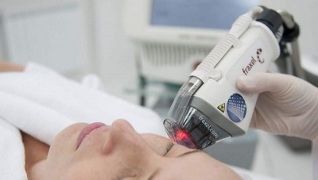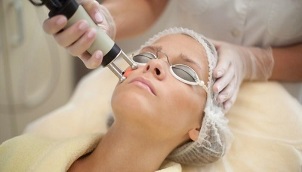
The main cause of skin aging is a deterioration in the functional capacity of metabolism and cell growth, as well as a slowdown in the elimination of toxins and toxins and a decrease in the supply of nutrients to cellular structures. Thanks to laboratory studies, it was known that this is a reversible process, that is, there is always the possibility of activating cell activity. Scientists have discovered that after thermal exposure to the laser, one part of the cells in the dermis becomes activated and the other part dies. As a general rule of thumb, dead cells die instead of living cells that don't have the potential to recover anymore.
In the process of weak cell death, the unoccupied intercellular space is occupied by stronger cells. The thermal effect that appears after laser treatment activates cell activity, resuming cell renewal and growth. The quality and speed of cell repair depends on the diameter of the laser beam. Its thickness should not be more than 200 microns, then a layer of healthy and young skin will begin to form in the treated area.
For this reason, the laser resurfacing technique has been improved with the introduction of fractional thermolysis. In this process, the laser beam is divided into many microscopic rays, creating an impact mesh structure in the treatment area. The innovative value of the technology lies in the fact that the laser works in local areas, which preserves the areas of the skin intact; accelerate skin regeneration and healing.
Fractional thermolysis varieties
Fractional laser resurfacing has been used successfully to tighten and firm skin in one of two ways. They differ in the characteristics of the action of the laser, the depth of its penetration and the impact in certain areas.

The first method of action, fractional photothermolysis, affects the upper epidermal cells, literally evaporating them. In other words, with this method, only the upper dermal layer is exposed.
The second method of treatment affects the epidermal and lower dermal layers, leaving the upper layer of the skin intact. In both cases, the laser beam has a local effect. A zone of cellular programming is preserved around the treated areas, which constitutes the potential for further regeneration of the skin. In other words, heat shock activates new cell growth and metabolic processes in cells.
The first fractional photothermolysis method removes the superficial microscopic areas of skin cells, tightens the treated areas in a short time, so the results after the procedure are immediately noticeable. It smoothes out superficial wrinkles and is therefore considered ideal for removing the first signs of age-related skin changes.
The second method of influence of the laser is suitable for solving problems deep within the skin, when the aging process is already irreversible. This method is a kind of "heavy artillery" laser resurfacing. Acting on the deep layers of the epidermis and dermis, the laser initiates metabolic processes, forms a new membrane framework, activates the production of collagen, so that the skin becomes younger and regenerates from the inside.
The maximum efficiency of fractional photothermolysis has been shown to be achieved by the combined use of two exposure methods. In this case, the skin will receive a double effect, both external and internal, which provides a long-term skin rejuvenation effect. A similar technique is used by a large number of modern medical institutions that have modern laser equipment at their disposal.
Procedure efficiency
You can ensure that after fractional laser resurfacing your skin becomes even, smooth and radiant after the first procedure. In a week, the oval of the face will be noticeably tightened, wrinkles will be smoothed and the complexion will be leveled. To consolidate and extend the result, a course of procedures will be required at one-month intervals.
With the combined fractional rejuvenation, the effect of a youthful skin is achieved much faster and lasts longer, up to 2-3 years. Of course, the results depend a lot on the lifestyle of each patient. Quitting bad habits, preventive facial care, a healthy lifestyle, adequate and adequate sleep help prolong the youth of the skin and prevent the aging and discoloration process.
The undoubted advantage of the procedure is that it does not hurt. The specialist uses superficial anesthesia, so during the procedure, the patient feels only a slight tingling sensation in the affected area.
Procedure progress

The undoubted advantage of the procedure is that it does not hurt. The specialist applies superficial anesthesia, therefore, during the procedure, the patient feels only a slight tingling sensation in the affected area. The anesthetic is applied shortly before the start of the session, which can last up to an hour; it all depends on the surface of the treatment.
After the procedure, the specialist advises the client on the necessary skin care, treats it with special medications.
Immediately after the procedure, the skin does not need any additional care. It will take a little over a week for you to get back to your normal rhythm of life, while rehabilitation after surgery is much more difficult and longer.
For the first two days, the face will be puffy, after which it will turn slightly red. After 4-7 days, the dead cells will begin to cleanse, revealing fresh, youthful skin.
Instructions for the procedure
If there is any doubt about the effectiveness of fractional laser resurfacing, then it is worth visiting the procedure to start according to the indications, of which there are many:
- Akne.
- Pigmentation.
- Spider veins, stretch marks and scars.
- Large pores.
- Wrinkles, crow's feet around the eyes.
- Flabby, withered and loose skin.
Contraindications to the procedure
As with any salon procedure, fractional rejuvenation has several contraindications:
- Benign and malignant growths in the treatment area.
- Cancer and continuous chemotherapy
- Dermatosis and photodermatosis, in the area of the procedure.
- Herpes infection in a month.
- Acute infectious infections, immunodeficiency.
- Chronic diseases such as bleeding disorders, diabetes mellitus, thromboembolic diseases.
- Psoriasis and hypertension.
- History of keloid or vitiligo scars, family history of vitiligo or keloids.
- Fresh tan, recent tan visit.
- Period of pregnancy and lactation.
- Use of retinoids in the last six months.
Combination of fractional rejuvenation with other procedures
This procedure is always carried out only after a preliminary consultation with a cosmetologist. With pronounced age-related changes, laser skin resurfacing will provide maximum efficiency and not a fractional resurfacing method.
In some cases, it will not be possible to do without surgical manipulations, such as endoscopic face lift, blepharoplasty or insertion of threads to tighten. However, laser resurfacing will help maintain and improve the effectiveness of the procedures. It will complement your results and refine the appearance of the client.
Laser resurfacing methods are perfectly combined with procedures such as mesotherapy and plasma lifting, as well as hyaluronic acid-based biorevitalization.







































